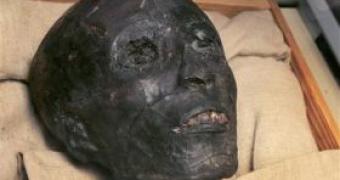Those fascinated by the ancient Egypt have been waiting for this moment for 85 years, since the discovery of the famous mummy of the 19-year-old "Boy Pharaoh" by Howard Carter: as from yesterday the public can see the 3,000-year-old face of Tutankhamon in his tomb in the famous Valley of the Kings.
The mummy has a shriveled leathery black face and body and it is exposed in a climate-controlled glass box, but only the face and feet are exposed under the linen wrapping.
"The golden boy has magic and mystery, and therefore every person all over the world will see what Egypt is doing to preserve the golden boy, and all of them I am sure will come to see the golden boy," said Egypt's antiquities chief, Zahi Hawass.
"Scientists began restoring King Tut's badly damaged mummy more than two years ago. Much of the mummy's body is broken into 18 pieces - damage sustained when British archaeologist Howard Carter discovered the mummy, took it from his tomb and tried to pull off his famous golden mask," said Hawass.
But mass tourism could further damage the mummy, as thousands of people will enter the underground tomb monthly. "The humidity and heat caused by ... people entering the tomb and their breathing will change the mummy to a powder. The only good thing (left) in this mummy is the face. We need to preserve the face," said Hawass.
Tutankhamun's fame came mostly from the fact that his tomb was found intact (by not being detected by thieves along the centuries), delivering to Carter on Nov. 4, 1922 a trove of gold and precious stones. Tutankhamon was the 12th king of Egypt's 18th dynasty and was crowned when being about 8 years old.
Tutankhamon died in 1323 B.C., apparently from an infection on his left thigh, perhaps due to a hunting accident. CT scan of the mummy showed that the boy king was well-fed, healthy, being 5-foot-6 in (168 centimeters) tall. The young king shared an overbite common to other pharaohs of his family, with large incisor teeth and slightly misaligned lower teeth.
"More than 9 million tourists visited Egypt last year - up from 8.7 million the previous year," signaled the Egyptian Tourist Authority.
"The tourists will begin viewing the mummy Monday. The mummy will remain in the tomb indefinitely - unlike other Egyptian royal mummies, who are displayed in museums." said Hawass.
"Tourists won't be the only ones to benefit from putting Tut on display in a climate-controlled case. In some ways, it could be advantageous to monitor the condition to see if the mummy is stable," John Taylor, an assistant keeper at the British Museum's department of ancient Egypt and Sudan told MSNBC.
"Along with putting Tut on display, experts will begin another project trying to determine the pharaoh's precise royal lineage. It is unclear if he is the son or a half brother of Akhenaten, the "heretic" pharaoh who introduced a revolutionary form of monotheism to ancient Egypt (related to Jew Mosaic religion) and was the son of Amenhotep III." said Hawass.
"Everyone is dreaming of what he looks like. The face of Tutankhamun is different from any king in the Cairo museum. With his beautiful buck teeth, the tourists will see a little bit of the smile from the face of the golden boy," he added.

 14 DAY TRIAL //
14 DAY TRIAL //